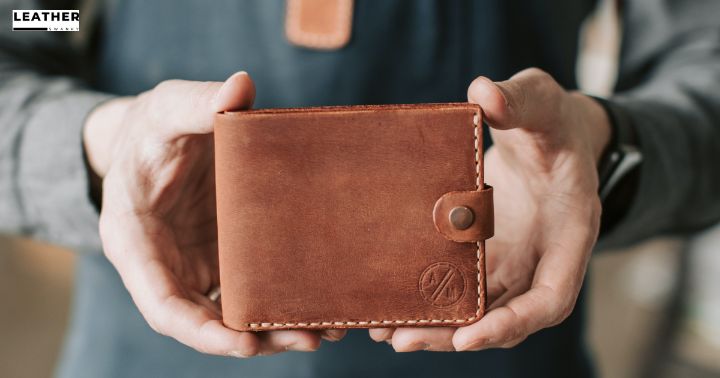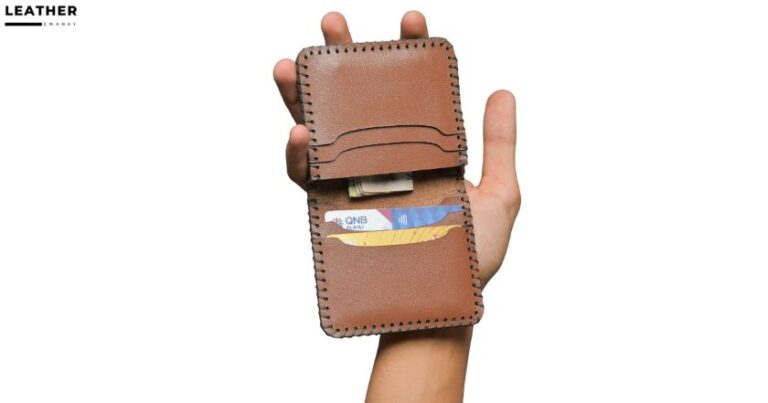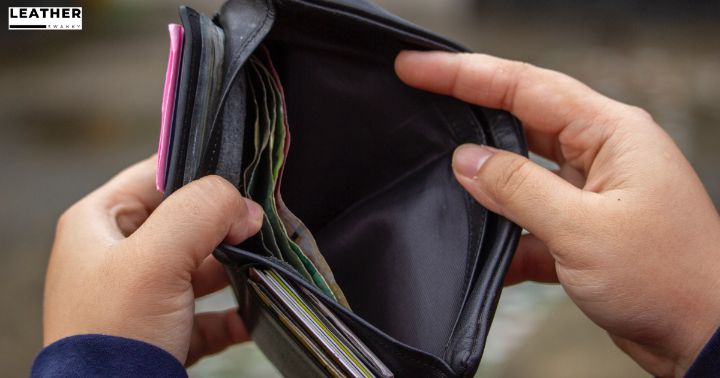Can You Repair Leather Wallets? 5 Best Methods To Do It
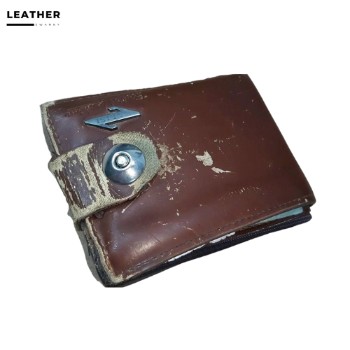
Is your favorite leather wallet showing signs of wear? Whether it’s fraying, cracked, or otherwise damaged, you may be wondering if it can be repaired.
The good news is that repair is often possible with the right information and materials.
To repair leather wallet, first evaluate the extent of damage. Next, use a leather repair kit for seamless fixes. Afterward, restore its luster by cleansing and conditioning the leather. Finish by safeguarding it with a leather protectant and precise application of leather adhesive.
In this article, we’ll cover in-depth how can you repair leather wallets, different types of leather wallets, common issues that occur over time, how to identify and fix specific problems, the advantages and disadvantages of repairing leather wallets, and tips for maintenance.
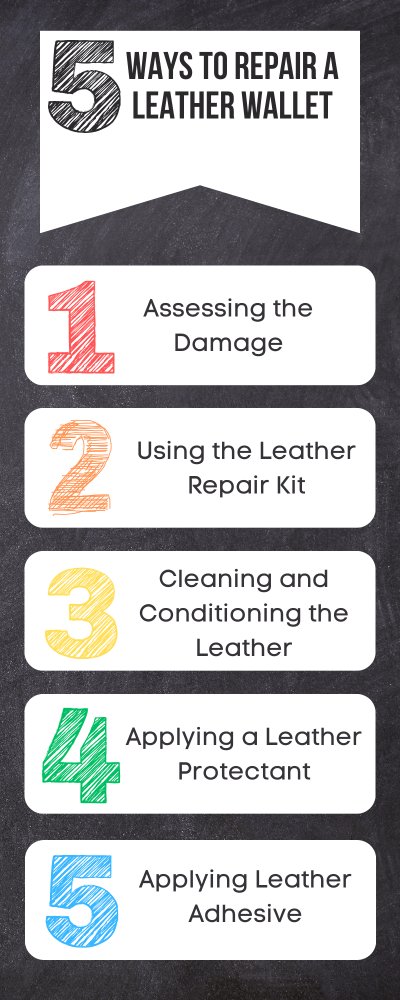
Jump to a Specific Section
- 1 Summary
- 2 Understanding Different Types of Leather and Wallets
- 3 Common Issues With Leather Wallets?
- 4 Identifying and Fixing Specific Problems With a Leather Wallet
- 5 How To Repair A Leather Wallet?
- 6 Advantages and Disadvantages of Repairing Leather Wallets
- 7 Tips and Tricks for Maintaining and Extending the Lifespan of Leather Wallets
- 8 Final Thoughts
- 9 Frequently Asked Questions
- 10 Resource Used for Research
Summary
- Different types of leather require different care and repair methods.
- Some repairs may require specialized tools or materials.
- Professional repair services may be necessary for severe cases.
- Proper care and maintenance can prevent common issues and extend the lifespan of a leather wallet.
Understanding Different Types of Leather and Wallets
Knowing the different types of leather and wallets is key to repairing them. Leather can range from smooth, soft calfskin to stiffer, textured suede.
Different types of leather require different care and repair methods. When it comes to wallets, they come in a variety of shapes and sizes.
Some may be made with one or two layers of leather while others have multiple compartments that are stitched together.
It’s important to understand the type of wallet you are working with as some repairs may require specialized tools or materials.
Common Issues With Leather Wallets?
Leather, a timeless material, is revered for its classic look, durability, and ability to age gracefully.
However, like all natural materials, it’s vulnerable to certain issues such as cracking, tearing, fading, and wear and tear.
With regular use and exposure to various elements, leather wallets may exhibit the following problems.
1. Cracking of Leather
Leather is a natural material that requires hydration. Leather’s natural moisture diminishes over time, leading to potential cracks. The cracking can be due to different factors.
The main factors due to which cracks appear are water, sweat, oils from the leather, and prolonged exposure to UV rays in sunlight
2. Torn or Ripped Leather
A wallet that’s frequently overstuffed or handled roughly may start to get worn, torn in spots, and develop rips.
The seams, being high-stress points, are particularly vulnerable. Gentle usage and resisting the urge to overfill can curtail this issue.
3. Fading or Discoloration of Leather
Constant exposure to sunlight or contact with harsh chemicals can result in the color of the leather fading.
Direct sunlight, in particular, can bleach the wallet, leading to an uneven appearance. You may also get stains of coffee, tea, and dirt on your wallet.
These stains will affect the leather directly. If you don’t clean your wallet and the colors are still on your purse for a long time, this will start discoloring faster.
4. Wear and Tear
General daily use can lead to scuffs, scratches, and the leather becoming thin in certain areas, especially in the folds or where cards and coins exert pressure.
While a patina might develop, adding character, it’s wise to be gentle and avoid abrasive interactions to minimize visible wear.
Identifying and Fixing Specific Problems With a Leather Wallet
You might be wondering if you can fix a leather wallet’s edge seams, repair a ripped or torn one, buff out scratches, mend frayed stitches, and replace broken hardware.
The answer is yes. With the right tools and techniques, you can restore your beloved leather wallet to its former glory.
You just have to know how to identify the specific issue and how to go about fixing it.
Can You Fix a Leather Wallet’s Edge Seams
Repairing the edge seams of a leather wallet is possible, but it can be tricky.
Depending on the type of leather and filler used to construct the wallet, you’ll need to use different techniques for repairs.
To fix an edge seam:
1. Gently pull apart the two edges
2. Apply a thin layer of leather filler to both sides where necessary
3. Sew together with a strong thread
4. Buff and clean with a dry cloth
Working with leather goods requires patience, knowledge, and experience to ensure successful repairs.
Be sure you have all the right materials before attempting any fixes – this will help you avoid costly mistakes.
Can You Repair a Ripped or Torn Leather Wallet
If the leather wallet is ripped or torn, fixing it can be a challenge. To repair it, you’ll need to assess the damage and determine what type of adhesive to use.
If only the edges are torn, apply some leather conditioner then re-stitch them together. Use a flexible thread for best results.
If the wallet has been severely ripped, restore its shape with sandpaper and then apply an appropriate adhesive before stitching it together again.
You may also need to replace any snapped fastenings such as zips or snaps with new ones.
Can You Repair Scratched Leather Wallet
Scratched leather wallets can be restored to their former glory with a bit of elbow grease. To repair a scratched leather wallet, you will need:
- A Leather item cleaner and conditioner
- An applicator cloth or sponge
- A Leather colorant stain or dye
- Zipper lubricant if necessary
Start by cleaning the leather and then applying the leather colorant to blend in the scratches and restore the original look of your wallet.
Use an applicator cloth or sponge to apply the stain evenly across the surface of your wallet, paying special attention to any zippers that may have become stuck due to wear and tear.
If necessary, you can lubricate any zippers with zipper lubricant for proper functioning again.
Can You Repair Frayed Leather Stitches
To fix frayed leather stitches, you’ll want to have some needle and thread on hand. The first step is to pull out any loose threads with a pair of tweezers.
Then cut away the area that needs repair. If it’s a small hole, you can use a piece of matching leather patch to cover it up.
For larger holes or tears, use your needle and thread to restitch the wallet. Make sure that when you stitch the fabric, use even tension so the stitches are secure and tight.
Can You Repair Broken Wallet Hardware
Fixing broken wallet hardware can be tricky, but it’s possible with the right tools. To repair a leather wallet, here are four tips to keep in mind:
1. Check for wear and tear on all brass components
2. Replace any worn-out hardware with new pieces
3. Make sure the leather is in good condition before proceeding with repairs
4. If necessary, use glue or stitching to reattach any dangling parts.
With these steps, you can ensure that your leather wallet or purse is repairable. However, depending on the severity of the damage it may be best to consult an expert for help restoring your item.
How To Repair A Leather Wallet?
Repairing a leather wallet can seem like an intimidating task, but with the right tools and knowledge, it can be done.
Here are 5 steps to do it:
1. Assessing the Damage
Assessing the damage to a leather wallet is the first step in determining how best to repair it.
Carefully inspect the area that needs repair and take note of any tears, frays, or discolorations in the leather.
You’ll want to be sure you know exactly what kind of damage you’re dealing with before attempting any repairs:
- Is the leather torn?
- Is there any loose threading or fraying?
- Has the color faded or changed?
- Are there any areas that appear wet or damp?
If your wallet is simply dirty, cleaning it with a soft cloth and some rubbing alcohol will do wonders for restoring its natural luster and texture.
If it’s wet, let it dry completely then assess whether further repairs are needed.
With torn leather, carefully use scissors to trim away any loose threads, but don’t cut into the surrounding material as this may cause more damage than good.
2. Using the Leather Repair Kit
To properly use one of these kits, start by cleaning the leather product with a damp cloth.
This will remove dirt and debris from the surface that could compromise your results. Next, use a small brush to rub away any small tears in the leather.
If you’d like to fill any holes in your wallet, apply some of the included filler material with a knife.
Once it has dried, sand down any excess material so that it’s flush with the leather surface.
Finally, using a leather sealant will help protect your wallet from further damage. Sealing up those repaired areas will complete this process and get your wallet looking new again.
3. Cleaning and Conditioning the Leather
After cleaning the item with a damp cloth, it’s important to condition the leather to keep it looking its best. To do this, follow these steps:
- Use a leather spa to remove dirt from the leather surface and restore natural oils.
- Cut away any loose fibers with scissors to keep them from further damaging the wallet.
- Rub in some leather preservative, using circular motions for even coverage.
- Let the wallet sit for 8 hours so the preservative can penetrate deep into the leather fibers.
4. Applying a Leather Protectant
To ensure long-lasting durability, it’s important to apply a leather protectant. The kind of leather and color of your wallet will determine the type of protection you need.
To start, use an adhesive to insert the patch onto the affected area. Then, apply a thin coat of protectant over the entire wallet using a soft cloth or brush.
Make sure to focus on any areas prone to wear and tear such as corners and seams. Once all surfaces are coated evenly, let it dry for at least 30 minutes before handling it.
If needed, add another layer of protectant for extra protection against dirt or moisture.
5. Applying Leather Adhesive
Before applying leather adhesive, it’s important to ensure the patch is fully secure and won’t come off easily.
To do this, make sure the straps are tightly secured inside the wallet and that the length and width of the patch match up with any fabric on either side.
Furthermore, check for any cracks on the surface that could prevent a strong bond from forming between the materials.
Lastly, make sure all other patches have been securely applied before moving forward with this step.
Advantages and Disadvantages of Repairing Leather Wallets
Repairing leather wallets has its pros and cons. Natural leather is a durable material that, when cared for properly, can last for many years.
High-quality leather wallets are built to last and have the potential to become family heirlooms.
If you repair a strap or zipper on your wallet, it’s possible to maintain its beauty and extend its lifespan.
On the other hand, repairing a wallet may be difficult if you don’t have the right tools and materials at home.
Plus, removing everything from the wallet before starting repairs can be time-consuming.
| Pros | Cons |
|---|---|
| Durable material | Difficult without proper tools & materials |
| Potential to become an heirloom | Time-consuming to remove everything first |
| Can extend the lifespan of a wallet | Not always feasible to repair at home |
Overall, repairing a leather wallet can be rewarding if done correctly but caution should still be taken due to the delicate nature of natural leather.
Tips and Tricks for Maintaining and Extending the Lifespan of Leather Wallets
Taking the necessary steps to maintain and extend the lifespan of your wallet can help it last for many years.
To ensure that your wallet remains in optimal condition, here are a few tips and tricks:
- Make sure you check the warranty information when you purchase a new leather wallet. That way, if any normal wear and tear occurs over time, you’ll be covered by the warranty terms.
- If your leather wallet gets wet, let it dry overnight before putting it back together again. This will help prevent any mold or mildew from forming on the surface of the leather.
- Keep your leather wallet away from extreme temperatures; too much heat or cold can cause damage to the material over time.
- Regularly clean and condition your leather wallet with a gentle cloth and suitable cleaner to keep it looking new for longer periods of time.
Final Thoughts
You’ve now got the knowledge to repair your own leather wallet. You can fix small issues on your own, or take it to a professional if need be.
Regularly cleaning and conditioning your wallet will keep it in good shape for years to come.
With proper care and maintenance, you’ll be able to enjoy your leather wallet for years.
Frequently Asked Questions
What Is the Best Way to Clean a Leather Wallet?
Gently wipe the wallet with a dry, soft cloth to remove any dirt. Use a leather cleaner and conditioner for deeper cleaning, applying it in circular motions and letting it sit for a few minutes before wiping it off. Repeat as necessary until the wallet looks clean.
Can Leather Wallets Be Waterproofed?
Yes, leather wallets can be waterproofed. A protective spray or sealant applied to the wallet’s surface can help protect it from water damage. Be sure to test it in an inconspicuous area first and reapply as needed for optimal protection.
What Is the Best Way to Store a Leather Wallet?
To preserve the life of your leather wallet, store it in a cool, dry place. Avoid direct sunlight and heat as this will cause the leather to dry out and crack. Place the wallet in a breathable fabric pouch or box to protect it from dust and dirt.
What Is the Difference Between a Leather Wallet and a Synthetic Wallet?
A leather wallet is made of natural materials such as cowhide or lambskin, while a synthetic wallet is constructed from man-made fabrics. Leather wallets tend to be more durable and can develop a patina over time, while synthetic wallets are lighter and less expensive.
How Much Does It Typically Cost to Repair a Leather Wallet?
The cost of repairing a leather wallet typically depends on the extent of damage and the type of repair needed. Prices can range from a few dollars to upwards of $50 or more.

